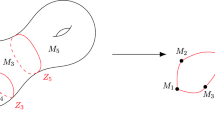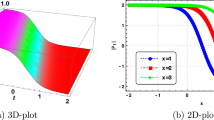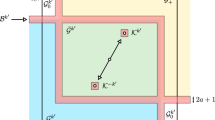Abstract
In this paper, we study bifurcation of limit cycles in cubic planar integrable, non-Hamiltonian systems. The systems are assumed to be Z2-equivariant with two symmetric centers. Particular attention is given to bifurcation of limit cycles in the neighborhood of the two centers under cubic perturbations. Such integrable systems can be classified as 11 cases. It is shown that different cases have different number of limit cycles and the maximal number is 10. The method used in the paper relies on focus value computation.
Similar content being viewed by others
References
Bautin N.N.: On the number of limit cycles which appear with the variation of coefficients from an equilibrium position of focus or center type. Mat. Sbornik (N.S.) 30, 181–196 (1952)
Chen L.S., Wang M.S.: The relative position, and the number, of limit cycles of a quadratic differential system. Acta. Math. Sinica 22, 751–758 (1979)
Han M.: On Hopf cyclicity of planar systems. J. Math. Anal. Appl. 245, 404–422 (2000)
Hilbert D.: Mathematical problems. (M. Newton, Transl) Bull. Am. Math. 8, 437–479 (1902)
Kukles I.S.: Necessary and sufficient conditions for the existence of center. Dokl. Akad. Nauk. 42, 160–163 (1944)
Li J.: Hilbert’s 16th problem and bifurcations of planar polynomial vector fields. Int. J. Bifurcations Chaos 13, 47–106 (2003)
Li J., Liu Z.: Bifurcation set and limit cycles forming compound eyes in a perturbed Hamiltonian system. Publications Mathematiques 35, 487–506 (1991)
Li C., Liu L., Yang J.: A cubic system with thirteen limit cycles. J. Differ. Equ. 246, 3609–3619 (2009)
Liu, Y., Li, J.: Z2-equivariant cubic systems which yield 13 limit cycles. Qualitative Theory Dyn. Syst. (to appear)
Liu Y.R., Li J.B., Huang W.T.: Singular Point Values, Center Problem and Bifurcations of Limit Cycles of Two Dimensional Differential Autonomous Systems. Science Press, Beijing (2008)
Malkin K.E.: Criteria for center of a differential equation. Volg. Matem. Sbornik 2, 87–91 (1964)
Shi S.: A concrete example of the existence of four limit cycles for plane quadratic systems. Sci. Sinica 11, 1051–1056 (1979) (in Chinese); 23 (1980), 153–158 (in English)
Yu P.: Computation of normal forms via a perturbation technique. J. Sound Vib. 211, 19–38 (1998)
Yu P., Han M.: Twelve limit cycles in a cubic case of the 16th Hilbert problem. Int. J. Bifurcation Chaos 15, 2191–2205 (2005)
Yu P., Han M.: Small limit cycles bifurcating from fine focus points in cubic order Z2-equivariant vector fields. Chaos Solitons Fractals 24, 329–348 (2005)
Author information
Authors and Affiliations
Corresponding author
Rights and permissions
About this article
Cite this article
Yu, P., Han, M. & Li, J. Bifurcation of Limit Cycles in Cubic Integrable Z2-Equivariant Planar Vector Fields. Qual. Theory Dyn. Syst. 9, 221–233 (2010). https://doi.org/10.1007/s12346-010-0025-6
Received:
Accepted:
Published:
Issue Date:
DOI: https://doi.org/10.1007/s12346-010-0025-6




